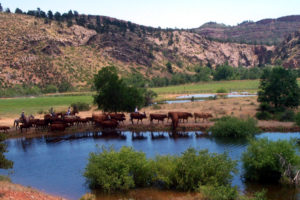Can you invent a term for what these pigs do? Enter our Naming Contest Today!
When Joel Salatin of Polyface Farm put his pigs to work making compost out of the manure and wood chips in his barn, he coined the term, “Pigerator” to describe what they do.
We need a new term to describe the work pigs are doing to one of our pastures at Sylvan Dale Ranch.
The pasture is an unproductive swath of sod-bound fescue just south of our Big Valley Lakes. The forage lacks variety because the fescue chokes out any other plants that try to sprout there. Our cattle graze it every year, but the soil is compacted and the growth is meager. This pasture badly needs regeneration.
The traditional remedy is to spray the old grass with herbicide to kill it, then plow, disk, harrow, reseed, and fertilize, then let the new pasture grow for a year to get established. Unfortunately, this method harms soil fertility. As an alternative, we tried mob grazing with cattle. By packing a large number of 1300 lb. cows into a small area of pasture, we hoped the churning impact of cow hooves would damage the fescue enough to allow a new seed mixture, broadcast on the ground and “planted” by the cows, to germinate and add some variety to the pasture.
It didn’t work. That fescue sod is tough!
Enter the pigs, courtesy of Spring Kite Farm, a new Sylvan Dale agri-partner. Michael Baute and Meghan are young farmers based in Ft. Collins, Colorado. For several years they have successfully grown vegetables to supply local customers and restaurants, and were looking for more land to lease in order to expand operations and introduce pigs, chickens and goats into their mix of offerings. Sylvan Dale Ranch raises grass-fed, grass-finished beef, along with enough hay to fuel our horse heard and get the cattle through the winter. Why not join forces with Spring Kite Farm and together, create a truly holistic, comprehensive agriculture operation?
At some point during these discussions it dawned on us that pigs might be able to do what the cows couldn’t: churn up the pasture enough to weaken or destroy the fescue as a prelude to re-seeding. Pigs don’t just graze, they root. Those amazing snouts might turn enough soil and gobble up enough of those pesky fescue rhizomes to open up the sod for new plants. Worth a try. We decided to start small to see if it works
You can see the results in this video https://youtu.be/oXgHcUfSfpU. Pretty impressive, we think. Pigs doing the work of machines. What should we call them? What should we call the work they are doing? We’ve started googling synonyms for “plowing” and for “pigs” to come up with ideas, but we haven’t got there yet. Here’s where you come in.
We invite you to a naming contest! Use the “Comments” feature on this blog to send in your entry. A distinguished panel of judges will select the winner!


 Here at Sylvan Dale we are using cattle to help build up organic matter and carbon content of our soils. The technique: planned, rapid rotation grazing. It turns out this also helps the soil conserve water. Here’s a post from Dr. Roy Roath, CSU Professor Emeritus, describing a grazing experiment he conducted on range land in Northern Colorado:
Here at Sylvan Dale we are using cattle to help build up organic matter and carbon content of our soils. The technique: planned, rapid rotation grazing. It turns out this also helps the soil conserve water. Here’s a post from Dr. Roy Roath, CSU Professor Emeritus, describing a grazing experiment he conducted on range land in Northern Colorado:
